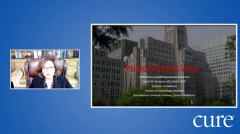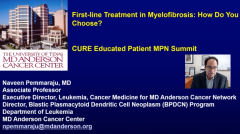
Educated Patient® MPN Summit First-line Treatment in Myelofibrosis Presentation: November 19, 2022
Watch to Dr. Naveen Pemmaraju, from The University of Texas MD Anderson Cancer Center, discuss frontline treatment options for patients with myelofibrosis during the CURE® Educated Patient® MPN Summit.
Episodes in this series

When determining the optimal frontline treatment for myelofibrosis —a type of myeloproliferative neoplasm (MPN) — it is important to not only consider clinical factors, but also symptom burden, disease progression, spleen size and others, according to Dr. Naveen Pemmaraju.
Pemmaraju, who is an associate professor and executive director of leukemia, cancer medicine at The University of Texas MD Anderson Cancer Center in Houston, recently discussed how to choose a frontline treatment for myelofibrosis at CURE®’s Educated Patient® MPN Summit.
“We apply the risk scoring for prognosis, disease survival, overall survival and then develop a treatment plan, which oftentimes incorporates JAK inhibitors,” Pemmaraju said in his presentation. “But let’s not forget about allogeneic stem cell transplant, as still the only curative option for the patient with myelofibrosis in 2022.”
When it comes to JAK inhibitors, there are currently three that have Food and Drug Administration (FDA) approval: Jakafi (ruxolitinib); Inrebic (fedratinib); and Vonjo (pacritinib).
There are also other therapies — momelotinib, Jakafi combinations and NS-018 — that are being studied and are seeking FDA approval, Pemmaraju explained.
The major upside to JAK inhibitors, though, is that they reduce spleen size and thereby decrease symptom burden for patients with myelofibrosis. However, Pemmaraju mentioned not all JAK inhibitors are created equally, and patients and their providers should discuss potential side effects with each drug.
For example, Inebric carries a black box warning for Wernicke encephalopathy, a degenerative brain disorder that is caused by the lack of vitamin B1, known as thiamine.
Jakafi has been associated with cytopenias (decreases in certain types of blood cells), that can put patients at a higher risk of infection. And momelotinib is associated with decreased thrombocytes (a type of white blood cells), as well as increased liver enzymes.
Studies have also shown that Vonjo is associated with gastrointestinal side effects, such as diarrhea and nausea.
While JAK inhibitors can improve prognosis for patients with myelofibrosis, allogeneic stem cell transplant — that is taking stem cells from healthy patients and infusing them to those with myelofibrosis — is still the only curative option for this patient population.
“Intermediate- to high-risk patients, or those with high-risk qualities who have a decreased overall survival and a fit performance status do benefit from the administration of allogeneic stem cell transplant,” Pemmaraju said. “Now two-, three- and even five-year datasets show the safety in selected high-risk patients.”
Ultimately, when choosing a frontline therapy — be it an approved regimen or participation in a clinical trial — patients and providers must weigh the pros and cons of the options to come to a sound decision of what is best for the individual patient.
“What's the added toxicity? What's the added burden to our patients? Is it worth it? We need to look at all of this very carefully together,” Pemmaraju said.
For more news on cancer updates, research and education, don’t forget to














